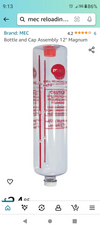I vote "No" and here's the reason....
The canister that the powder was sold in has the ability to dissipate static electricity. It has a slightly conductive surface, either by post-treatment or compounds added to the plastic at the time of molding. Most of us know about the pink "anti-static" bags for computer boards, well this is very similar. Except that in place of protecting transistors, this is to reduce the possibility of fire due to static charge build-up. This is why you see all powders come in the same ugly, black canisters, and never yellow, purple or blue. I highly suspect that the conductive ingredient added to the plastic is black graphite, but smarter people will need to talk about that.
Obviously, the possibility of ignition is much lower with smokeless powders than it is with primers. Powders are only "flammable" whereas primers are true "explosives". But primers also have their own types of protective packaging and no one in the their right mind swaps out those containers.



